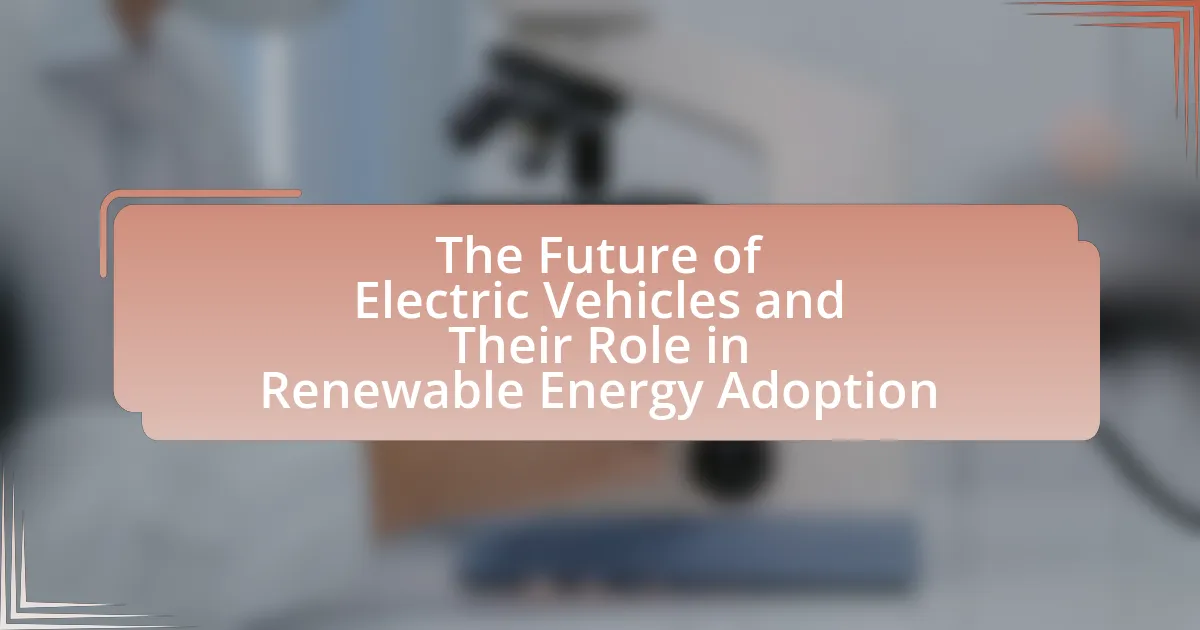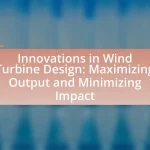The article focuses on the future of electric vehicles (EVs) and their integral role in the adoption of renewable energy. It highlights the projected growth of EV sales, advancements in battery technology, and the importance of integrating renewable energy sources into charging infrastructure. The article discusses the environmental benefits of EVs, including significant reductions in greenhouse gas emissions, and outlines the challenges faced in infrastructure and consumer adoption. Additionally, it examines the impact of government policies and economic factors on the transition to electric vehicles, emphasizing the need for increased incentives and charging networks to facilitate this shift towards sustainable transportation.
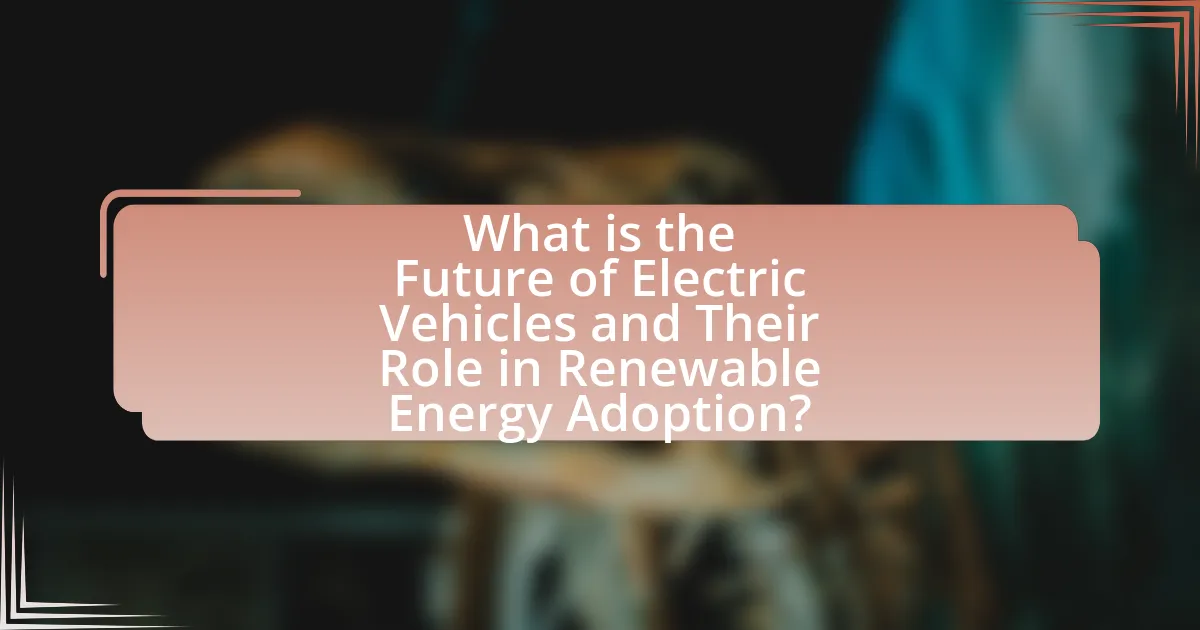
What is the Future of Electric Vehicles and Their Role in Renewable Energy Adoption?
The future of electric vehicles (EVs) is closely tied to the adoption of renewable energy, as they are expected to significantly reduce greenhouse gas emissions and reliance on fossil fuels. As of 2023, global EV sales are projected to reach 30% of total vehicle sales by 2030, driven by advancements in battery technology and government incentives promoting clean energy. This shift will enhance the integration of renewable energy sources, such as solar and wind, into the grid, as EVs can serve as energy storage systems, allowing excess renewable energy to be utilized efficiently. Studies indicate that widespread EV adoption could lead to a 70% reduction in transportation-related emissions by 2050, underscoring their critical role in achieving climate goals.
How are electric vehicles evolving in the context of renewable energy?
Electric vehicles (EVs) are evolving significantly in the context of renewable energy by integrating advanced technologies that enhance their efficiency and sustainability. This evolution includes the development of vehicles that can utilize renewable energy sources, such as solar and wind, for charging, thereby reducing reliance on fossil fuels. For instance, some EV manufacturers are incorporating solar panels into vehicle designs, allowing cars to harness solar energy directly. Additionally, the expansion of charging infrastructure powered by renewable energy sources is facilitating the transition to cleaner energy for EVs. According to the International Energy Agency, the share of electric vehicles in global car sales reached 9% in 2021, reflecting a growing trend towards sustainable transportation solutions that align with renewable energy goals.
What technological advancements are driving the future of electric vehicles?
Technological advancements driving the future of electric vehicles include improvements in battery technology, enhanced charging infrastructure, and advancements in autonomous driving systems. Battery technology, particularly the development of solid-state batteries, offers higher energy density and faster charging times, which can significantly extend the range of electric vehicles and reduce charging duration. For instance, solid-state batteries can potentially increase energy density by up to 50% compared to traditional lithium-ion batteries, as reported by the U.S. Department of Energy.
Additionally, the expansion of fast-charging networks is crucial for the widespread adoption of electric vehicles, with companies like Tesla and ChargePoint investing heavily in ultra-fast charging stations that can recharge vehicles in under 30 minutes. This infrastructure development is essential for alleviating range anxiety among consumers.
Moreover, advancements in autonomous driving technology, such as improved sensor systems and artificial intelligence algorithms, are enhancing the safety and efficiency of electric vehicles. According to a report by McKinsey & Company, the integration of autonomous features can lead to a 15% reduction in energy consumption, further promoting the sustainability of electric vehicles. These technological advancements collectively position electric vehicles as a key component in the transition to renewable energy adoption.
How do electric vehicles integrate with renewable energy sources?
Electric vehicles (EVs) integrate with renewable energy sources by utilizing charging infrastructure that is powered by solar, wind, or hydroelectric energy. This integration allows EVs to operate with minimal carbon emissions, as the electricity used for charging can be generated from clean sources. For instance, studies show that charging EVs with solar energy can reduce greenhouse gas emissions by up to 90% compared to traditional fossil fuel-powered vehicles. Additionally, EVs can serve as energy storage systems, enabling the grid to balance supply and demand by discharging stored energy back into the grid during peak times, further enhancing the efficiency of renewable energy utilization.
Why is the adoption of electric vehicles important for renewable energy?
The adoption of electric vehicles (EVs) is crucial for renewable energy because it enhances the integration of clean energy sources into the transportation sector. EVs can utilize electricity generated from renewable sources such as solar and wind, which reduces reliance on fossil fuels and lowers greenhouse gas emissions. According to the International Energy Agency, transitioning to electric vehicles could reduce global CO2 emissions by up to 1.5 gigatons annually by 2030, significantly contributing to climate change mitigation efforts. This synergy between EVs and renewable energy not only promotes sustainability but also supports the growth of renewable energy infrastructure, creating a more resilient energy system.
What environmental benefits do electric vehicles provide?
Electric vehicles (EVs) provide significant environmental benefits, primarily by reducing greenhouse gas emissions. Unlike traditional gasoline or diesel vehicles, EVs produce zero tailpipe emissions, which contributes to improved air quality and lower levels of pollutants such as nitrogen oxides and particulate matter. According to the U.S. Environmental Protection Agency, transportation accounts for nearly 29% of total greenhouse gas emissions in the United States, and transitioning to electric vehicles can substantially decrease this figure. Additionally, when charged using renewable energy sources, the overall carbon footprint of EVs is further minimized, promoting a cleaner energy ecosystem. Studies indicate that widespread adoption of electric vehicles could lead to a reduction of up to 70% in greenhouse gas emissions by 2050, highlighting their crucial role in combating climate change.
How do electric vehicles contribute to reducing carbon emissions?
Electric vehicles (EVs) contribute to reducing carbon emissions by eliminating tailpipe emissions and utilizing cleaner energy sources. Unlike traditional internal combustion engine vehicles, EVs do not emit carbon dioxide or other greenhouse gases during operation, which significantly lowers urban air pollution. Additionally, when charged using renewable energy sources such as solar or wind, the overall carbon footprint of EVs is further reduced. According to the U.S. Department of Energy, EVs can produce up to 60% lower lifetime greenhouse gas emissions compared to gasoline-powered vehicles, depending on the electricity source. This transition to electric mobility is crucial for achieving global climate goals and promoting sustainable energy practices.
What challenges do electric vehicles face in the renewable energy landscape?
Electric vehicles (EVs) face several challenges in the renewable energy landscape, primarily related to infrastructure, battery technology, and energy sourcing. The lack of widespread charging infrastructure limits the convenience and accessibility of EVs, making it difficult for consumers to adopt them fully. Additionally, current battery technology presents issues such as limited range, long charging times, and environmental concerns regarding battery production and disposal. Furthermore, the reliance on non-renewable energy sources for electricity generation can undermine the environmental benefits of EVs, as studies indicate that the carbon footprint of EVs can be significant if charged from fossil fuel-based grids. These challenges hinder the seamless integration of electric vehicles into a sustainable energy future.
What are the barriers to widespread adoption of electric vehicles?
The barriers to widespread adoption of electric vehicles include high upfront costs, limited charging infrastructure, range anxiety, and consumer awareness. High upfront costs deter potential buyers, as electric vehicles often have a higher purchase price compared to traditional vehicles, despite lower operating costs over time. Limited charging infrastructure creates challenges for users, as the availability of charging stations is crucial for convenience and accessibility. Range anxiety, the fear of running out of battery power before reaching a charging station, further discourages adoption, particularly in areas with inadequate charging options. Lastly, consumer awareness and understanding of electric vehicles’ benefits and capabilities remain low, impacting their willingness to transition from conventional vehicles. These factors collectively hinder the growth of electric vehicle adoption in the market.
How do infrastructure limitations affect electric vehicle usage?
Infrastructure limitations significantly hinder electric vehicle (EV) usage by restricting access to charging stations and creating range anxiety among potential users. For instance, a study by the International Council on Clean Transportation found that inadequate charging infrastructure is a primary barrier to EV adoption, with only 20% of U.S. drivers feeling confident about finding charging stations on long trips. Furthermore, regions with fewer charging points experience lower EV sales, as consumers prioritize convenience and accessibility. This correlation between infrastructure availability and EV uptake underscores the necessity for robust charging networks to facilitate widespread electric vehicle adoption.
How can the transition to electric vehicles be accelerated?
The transition to electric vehicles can be accelerated by increasing government incentives for EV purchases and expanding charging infrastructure. Government incentives, such as tax credits and rebates, have been shown to significantly boost EV sales; for instance, in the United States, the federal tax credit of up to $7,500 has contributed to a rise in electric vehicle adoption. Additionally, expanding the charging infrastructure is crucial, as studies indicate that the availability of charging stations directly influences consumer willingness to purchase electric vehicles. According to the International Energy Agency, a robust charging network can lead to a 50% increase in EV sales. Therefore, implementing these strategies can effectively speed up the transition to electric vehicles.
What role do government policies play in promoting electric vehicles?
Government policies play a crucial role in promoting electric vehicles by providing incentives, regulations, and infrastructure support. These policies include tax credits, rebates, and grants that lower the purchase cost of electric vehicles, making them more accessible to consumers. For instance, the U.S. federal government offers a tax credit of up to $7,500 for electric vehicle buyers, which has significantly boosted sales. Additionally, regulations such as emissions standards compel manufacturers to produce more electric vehicles, while investments in charging infrastructure enhance the convenience of owning an electric vehicle. According to the International Energy Agency, government policies have been instrumental in increasing global electric vehicle sales, which reached 10 million units in 2020, demonstrating the effectiveness of these initiatives in driving adoption.
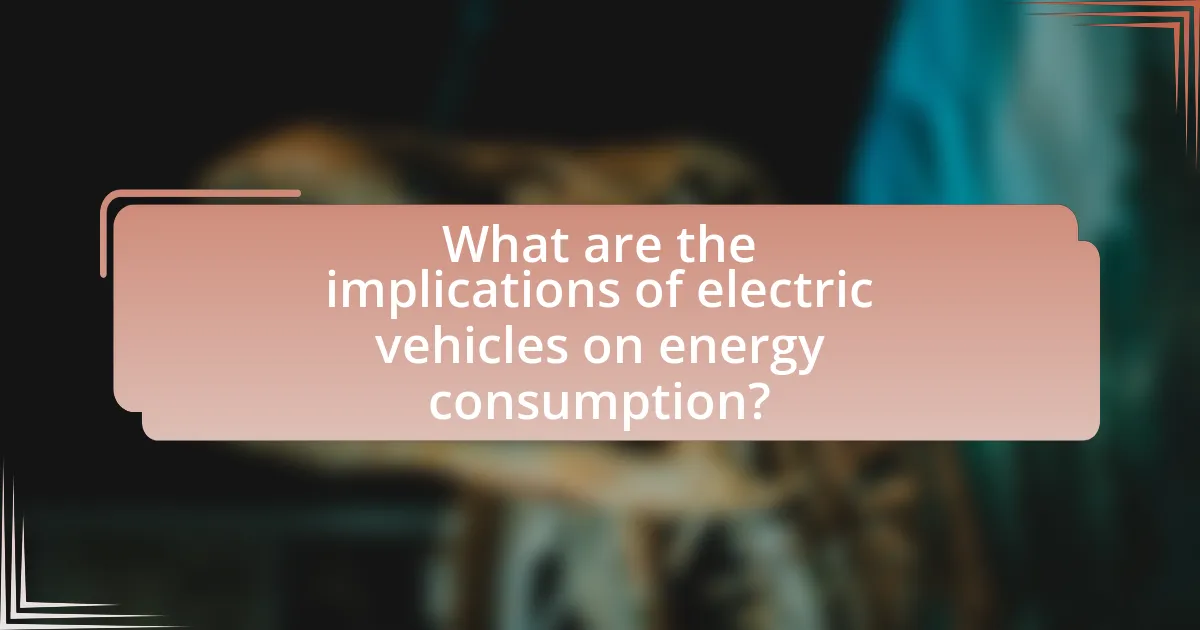
What are the implications of electric vehicles on energy consumption?
Electric vehicles (EVs) significantly impact energy consumption by increasing electricity demand while reducing reliance on fossil fuels. The transition from gasoline to electric power leads to a shift in energy consumption patterns, as EVs require charging infrastructure and electricity generation, which can be sourced from renewable energy. For instance, a study by the International Energy Agency (IEA) indicates that the global stock of electric cars could reach 145 million by 2030, resulting in a projected increase in electricity demand of around 1,500 terawatt-hours (TWh) annually. This shift can enhance energy efficiency and promote the integration of renewable energy sources, as EVs can serve as energy storage systems, enabling grid stability and facilitating the use of intermittent renewable resources like solar and wind.
How do electric vehicles impact energy demand and supply?
Electric vehicles (EVs) significantly increase energy demand while simultaneously influencing energy supply dynamics. As the adoption of EVs rises, the overall electricity consumption grows, with projections indicating that by 2040, EVs could account for approximately 10% of global electricity demand, translating to an increase of around 1,800 terawatt-hours annually. This surge in demand necessitates a corresponding expansion in energy supply, particularly from renewable sources, to ensure sustainability and reduce greenhouse gas emissions. Furthermore, EVs can enhance grid stability through vehicle-to-grid technology, allowing for energy storage and distribution during peak demand periods, thereby optimizing energy supply management.
What is the relationship between electric vehicle charging and renewable energy generation?
Electric vehicle charging is closely linked to renewable energy generation as it can utilize clean energy sources, reducing greenhouse gas emissions. When electric vehicles are charged using electricity generated from renewable sources like solar, wind, or hydro, the overall carbon footprint of transportation decreases significantly. For instance, a study by the International Energy Agency in 2021 indicated that integrating electric vehicle charging with renewable energy could lead to a reduction of up to 70% in emissions compared to conventional fossil fuel-powered vehicles. This synergy not only promotes sustainable transportation but also enhances the efficiency of renewable energy systems by providing a flexible demand that can help balance supply and demand on the grid.
How can smart grids facilitate electric vehicle integration?
Smart grids facilitate electric vehicle integration by enabling real-time communication between vehicles, charging stations, and the power grid. This technology allows for optimized charging schedules based on grid demand and renewable energy availability, reducing strain on the grid during peak times. For instance, smart grids can manage vehicle-to-grid (V2G) systems, where electric vehicles can return energy to the grid, thus enhancing grid stability and efficiency. According to a study by the National Renewable Energy Laboratory, integrating V2G technology can significantly reduce energy costs and improve the utilization of renewable energy sources, demonstrating the effectiveness of smart grids in supporting electric vehicle adoption.
What economic factors influence the future of electric vehicles?
The future of electric vehicles is significantly influenced by factors such as government incentives, battery technology costs, and the price of fossil fuels. Government incentives, including tax credits and subsidies, encourage consumer adoption and reduce the overall cost of electric vehicles, making them more competitive with traditional vehicles. For instance, in the United States, the federal tax credit for electric vehicles can be up to $7,500, which directly impacts purchasing decisions.
Additionally, advancements in battery technology are crucial; as production costs decrease, the price of electric vehicles is expected to drop, enhancing affordability. According to BloombergNEF, the cost of lithium-ion batteries has fallen by 89% since 2010, which is a key driver for the electric vehicle market.
Lastly, fluctuations in fossil fuel prices can also affect electric vehicle adoption. When oil prices rise, consumers are more likely to consider electric vehicles as a cost-effective alternative. For example, during periods of high gasoline prices, electric vehicle sales have historically seen a notable increase. These economic factors collectively shape the trajectory of electric vehicle adoption and their integration into the renewable energy landscape.
How do electric vehicle costs compare to traditional vehicles over time?
Electric vehicle costs are generally lower than traditional vehicle costs over time when considering total cost of ownership, which includes purchase price, fuel, maintenance, and incentives. A study by the International Council on Clean Transportation found that, as of 2021, the lifetime costs of electric vehicles can be up to 30% lower than those of gasoline vehicles due to lower fuel and maintenance expenses. Additionally, electric vehicles benefit from government incentives that can further reduce initial purchase prices, making them more economically favorable in the long run.
What incentives are available for electric vehicle adoption?
Incentives for electric vehicle adoption include federal tax credits, state rebates, and grants. The federal government offers a tax credit of up to $7,500 for qualifying electric vehicles, which can significantly reduce the purchase price. Additionally, many states provide their own incentives, such as rebates that can range from a few hundred to several thousand dollars, depending on the state and the vehicle’s specifications. Furthermore, some local governments and utility companies offer grants or additional rebates to encourage electric vehicle use. These incentives aim to promote cleaner transportation and reduce greenhouse gas emissions, aligning with broader renewable energy goals.
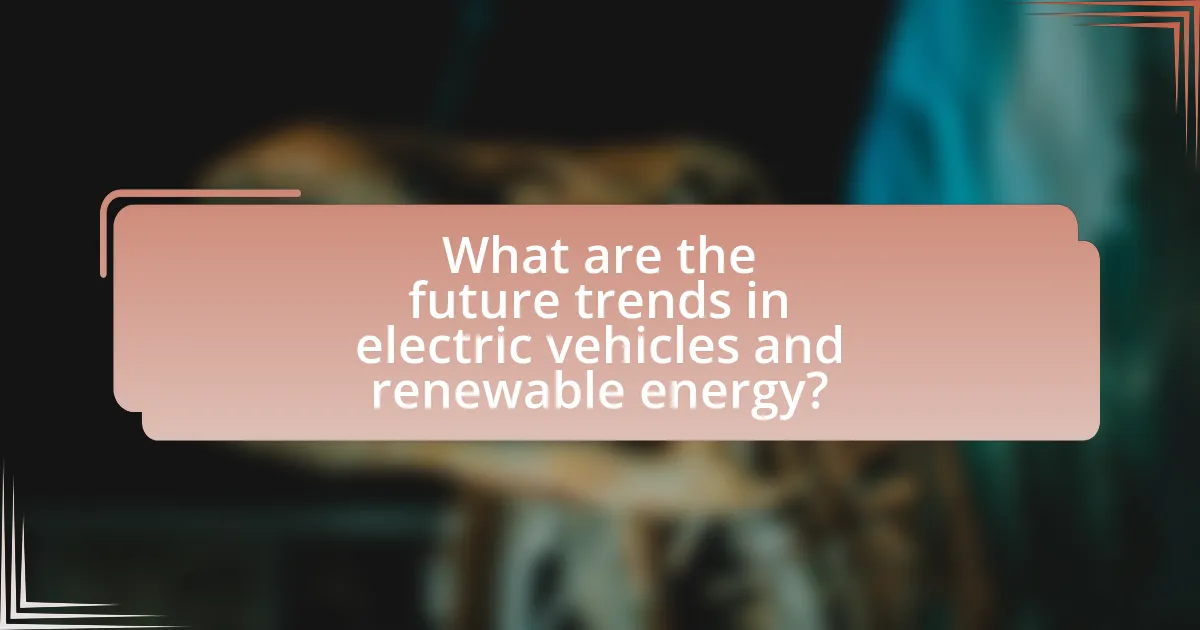
What are the future trends in electric vehicles and renewable energy?
Future trends in electric vehicles (EVs) and renewable energy include increased adoption of battery electric vehicles, advancements in battery technology, and the integration of renewable energy sources into charging infrastructure. The global electric vehicle market is projected to grow significantly, with estimates suggesting that by 2030, EVs could account for over 30% of new car sales, driven by government incentives and consumer demand for sustainable transportation. Additionally, innovations in battery technology, such as solid-state batteries, promise to enhance energy density and reduce charging times, further accelerating EV adoption. The synergy between EVs and renewable energy is also evident as more charging stations are powered by solar and wind energy, promoting a cleaner energy ecosystem. According to the International Energy Agency, the number of electric vehicles on the road reached 10 million in 2020, highlighting the rapid growth and potential for future expansion in this sector.
How will consumer preferences shape the future of electric vehicles?
Consumer preferences will significantly shape the future of electric vehicles (EVs) by driving demand for features such as sustainability, performance, and technology integration. As consumers increasingly prioritize environmental concerns, the demand for EVs is expected to rise; for instance, a 2021 survey by McKinsey found that 70% of consumers are willing to pay more for sustainable products. Additionally, preferences for advanced technology, such as autonomous driving and connectivity, will influence manufacturers to innovate and enhance vehicle offerings. The shift towards online purchasing and subscription models, as indicated by a 2022 Deloitte report, further illustrates how consumer behavior is prompting automakers to adapt their sales strategies and product designs. Thus, consumer preferences are pivotal in determining the direction of EV development and market growth.
What role does sustainability play in consumer decision-making?
Sustainability significantly influences consumer decision-making by driving preferences towards eco-friendly products and practices. Research indicates that 66% of global consumers are willing to pay more for sustainable brands, reflecting a growing trend where environmental considerations shape purchasing choices. This shift is particularly evident in the automotive sector, where consumers increasingly favor electric vehicles due to their lower carbon footprint compared to traditional gasoline cars. A study by Nielsen found that 73% of millennials are willing to pay extra for sustainable offerings, highlighting the importance of sustainability in attracting a younger demographic. Thus, sustainability not only affects consumer preferences but also compels companies to adopt greener practices to remain competitive in the market.
How are manufacturers responding to changing consumer demands?
Manufacturers are responding to changing consumer demands by increasing the production of electric vehicles (EVs) and enhancing their sustainability practices. For instance, major automotive companies like Tesla and Ford have significantly ramped up their EV offerings, with Tesla reporting a 50% increase in production capacity in 2022 to meet rising consumer interest in sustainable transportation. Additionally, manufacturers are investing in renewable energy sources for their production processes, with companies like BMW committing to using 100% renewable energy in their manufacturing plants by 2025. This shift not only aligns with consumer preferences for environmentally friendly products but also addresses regulatory pressures for lower emissions.
What innovations are expected in electric vehicle technology?
Innovations expected in electric vehicle technology include advancements in battery technology, such as solid-state batteries, which promise higher energy density and faster charging times. These batteries can potentially increase the range of electric vehicles significantly, with some projections suggesting ranges exceeding 500 miles on a single charge. Additionally, improvements in charging infrastructure, including ultra-fast charging stations and wireless charging systems, are anticipated to enhance user convenience and reduce downtime. Furthermore, the integration of artificial intelligence for better energy management and autonomous driving capabilities is expected to revolutionize the driving experience and efficiency of electric vehicles. These innovations are supported by ongoing research and development efforts from major automotive manufacturers and technology companies, aiming to accelerate the adoption of electric vehicles and their role in renewable energy integration.
How will battery technology evolve in the coming years?
Battery technology will evolve significantly in the coming years, focusing on increased energy density, faster charging times, and enhanced sustainability. Innovations such as solid-state batteries are expected to replace traditional lithium-ion batteries, offering higher energy capacities and improved safety. For instance, solid-state batteries can potentially provide up to 50% more energy density compared to current lithium-ion technologies, which would extend the range of electric vehicles. Additionally, advancements in battery recycling processes are being developed to reduce environmental impact, with companies like Redwood Materials leading efforts to reclaim valuable materials from used batteries. These developments are crucial for supporting the growing demand for electric vehicles and facilitating the transition to renewable energy sources.
What advancements in charging infrastructure are anticipated?
Anticipated advancements in charging infrastructure include the widespread deployment of ultra-fast charging stations, which can significantly reduce charging times to under 15 minutes for most electric vehicles. This development is supported by the increasing investment from companies like Tesla and ChargePoint, which aim to expand their networks to accommodate the growing number of electric vehicles on the road. Additionally, the integration of renewable energy sources, such as solar and wind, into charging stations is expected to enhance sustainability, as evidenced by initiatives like the Solar Electric Vehicle Charging Stations project in California. These advancements are crucial for supporting the transition to electric vehicles and promoting renewable energy adoption.
What practical steps can individuals take to support electric vehicle adoption?
Individuals can support electric vehicle (EV) adoption by purchasing EVs, advocating for EV-friendly policies, and promoting charging infrastructure development. By choosing to buy electric vehicles, individuals contribute to increased demand, which can lead to economies of scale and lower prices. Advocacy for policies such as tax incentives for EV buyers or funding for public charging stations can further enhance adoption rates. Additionally, supporting local initiatives to install more charging stations increases accessibility, making it easier for others to transition to electric vehicles. According to the International Energy Agency, global electric car sales reached 6.6 million in 2021, demonstrating the impact of consumer choices on market growth.
